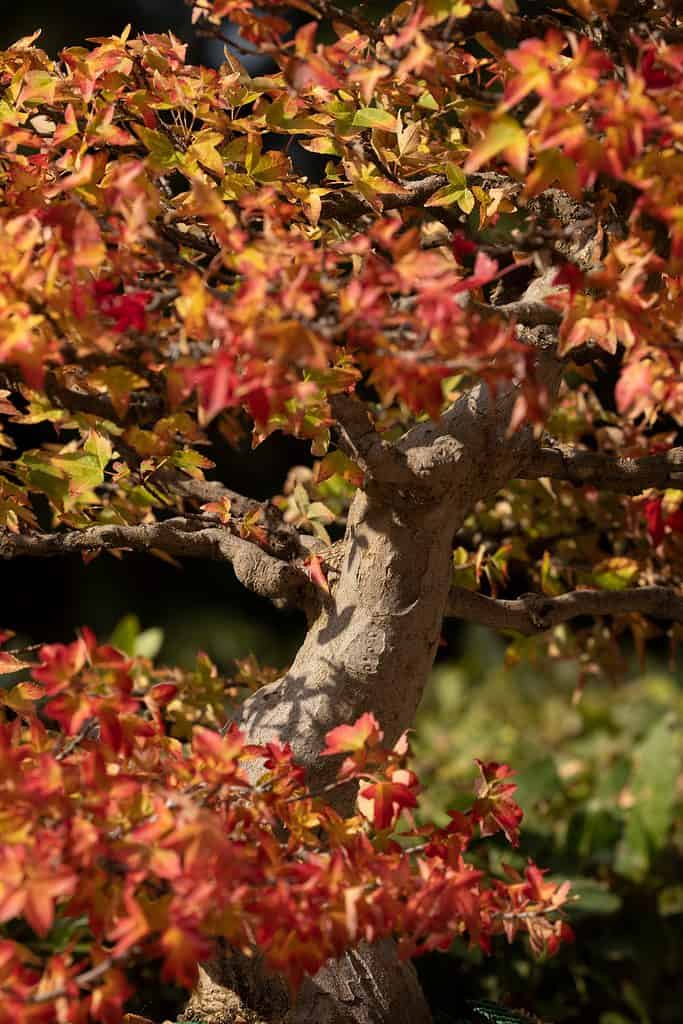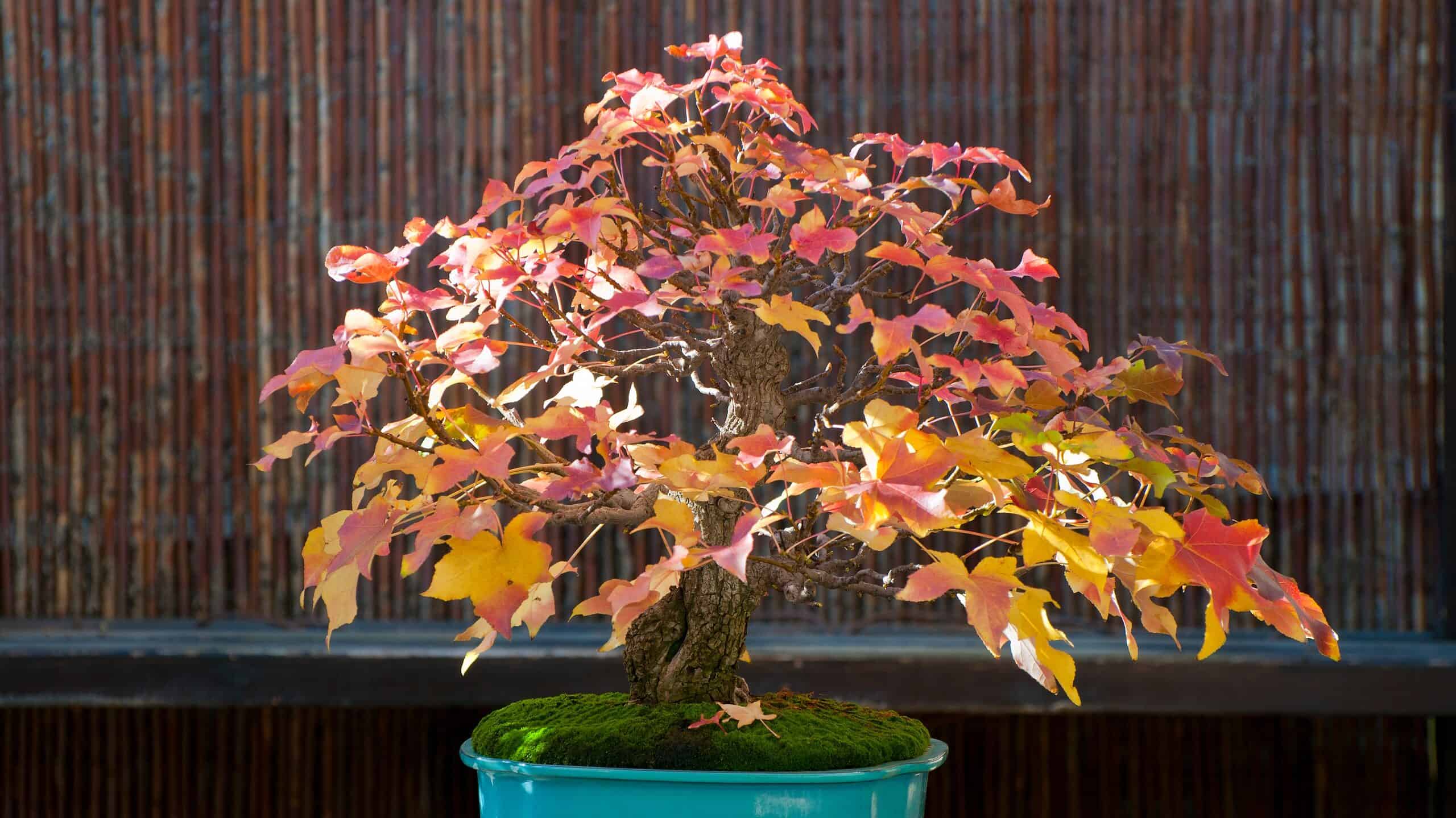Liquidambar trees, otherwise known as sweetgum trees, are named for the sap that pours out when the bark is cut. They are known for the lovely, distinctive coloring of their leaves whether it’s spring, summer, or fall. But did you know that liquidambar trees are perfect for Bonsai tree art?
In this handy guide, we’ve written all you need to know about caring for a liquidambar Bonsai tree!
| Botanical Name | Liquidambar |
| Common Types | Liquidambar styraciflua, Liquidambar formosana, Liquidambar acalycina ‘Burgundy Flush’, Liquidambar styraciflua ‘Slender Silhouette’, Liquidambar styraciflua ‘Variegata’, Liquidambar styraciflua ‘Gumball’ |
| Sunlight | Full sun for at least six hours a day |
| Soil | Moist, well-draining. Specialty Bonsai mixes will suit Liquidambar Bonsai trees well! |
| Water | Rootball should be kept moist. Water thoroughly when topsoil is dry to the touch. Prefers slightly acidic water. |
| For Beginners? | Yes! For the most part, liquidambar Bonsai trees are easy to care for and style. |
| Indoors or Outdoors? | Outdoors throughout the year. Bring inside if winter temperatures are extremely cold and/or frosty. |
| Pairs Well With… | Rocks and moss, other natural ornamentation |
Common Types of Liquidambar Bonsai Trees
Liquidambar trees, also known as sweetgum trees, can be found across the world. They are native to Asia, Europe, and North and Central America. There are only four or five species of liquidambar trees left in the world but many cultivars are available. All of them are suitable for Bonsai tree art! Here are some of the most common types of liquidambar Bonsai trees!

Known for the lovely, distinctive coloring of their leaves no matter the season, liquidambar trees are perfect for Bonsai tree art!
©alvarobueno/Shutterstock.com
Liquidambar styraciflua
Liquidambar styraciflua, also known as the American sweetgum tree, is probably the most popular type of liquidambar tree across the board. Known for their height, these trees can grow up to 80 feet tall when planted naturally!
Liquidambar styraciflua thrives best in full sun and moist, well-draining soil that is on the acidic side. They do not tolerate shade but they do tolerate heat and humidity. Because of this, they do not do well in cold conditions. Nor can they survive frost all that well.
Liquidambar formosana
Also known as the Chinese sweetgum, Liquidambar formosana trees are native to eastern Asia. These trees are more drought tolerant than other liquidambar varieties. When planted normally, they often grow around 40 to 60 feet and appear oval or pyramidal in shape.
Liquidambar formosana trees thrive best in full sun and, like other sweetgum trees, they cannot tolerate shade. They need moist, well-draining soil.
Liquidambar acalycina ‘Burgundy Flush’
Liquidambar acalycina, better known with the common name of Burgundy Flush, are also native to eastern Asia. The bark on these trees is brown or black colored. The leaves on a Burgundy Flush start out reddish in the spring when they bloom. That is where the name “burgundy flush” comes from! In the summer they turn green. But during the fall months, before they drop, the leaves are red and purple once again!
Liquidambar acalycina trees thrive best in full sun. Like other sweetgum trees, they cannot tolerate shade. They need moist, well-draining soil.
Liquidambar styraciflua ‘Slender Silhouette’
Liquidambar styraciflua of the Slender Silhouette cultivar are native to the state of Tennessee, where they grow in the wild. These trees can grow just as tall as other liquidambar trees but they are much more slender. On average, they are about 5 to 6 feet wide. Most other liquidambar trees are almost as tall as they are wide.
Slender Silhouette sweetgum trees are interesting because of the conditions in which they must be grown. To achieve slow growth and to keep them narrow, Slender Silhouette trees should be planted in poor soil conditions. If they are planted in ideal conditions — like in full sun and nutrient-rich soil — they can grow too fast and the trunk can even split.
Liquidambar styraciflua ‘Variegata’
The Variegata variety of Liquidambar styraciflua is very similar to the American sweetgum tree, its parent tree. The only major difference is that the leaves on the Variegata cultivar are variegated. The edges of the leaves are yellow in the spring and summer, while the rest of the leaf is green. In the fall months these leaves turn shades of purple, red, yellow, and orange.
Variegata liquidambar trees, when planted naturally, can reach heights of 70-80 feet. Like other sweetgum trees, these trees love full sunlight and cannot tolerate anything less. They are pickier than other sweetgum trees when it comes to growing conditions, though. They need acidic, well-draining soil rich in nutrients to thrive.
Liquidambar styraciflua ‘Gumball’
Another cultivar of the American sweetgum, Liquidambar styraciflua of the gumball cultivar is a dwarf variety. This makes it well-suited to Bonsai tree art. Funnily enough, this cultivar actually does resemble a gumball! It can reach about 6 feet tall and it is usually as tall as it is wide. In the spring and summer, the foliage on these trees turn lovely shades of purple, red, orange, and yellow.
Like other sweetgum trees, Liquidambar styraciflua of the gumball variety love full sunlight and cannot tolerate anything less. They also like moist, well-draining soil.
Caring for Your Liquidambar Bonsai Tree
Liquidambar trees are not low or high maintenance across the board. There are some cultivars that are easier to care for than others, so it is important to know which liquidambar cultivar you are growing!
In this handy guide, we cover everything about caring for a liquidambar Bonsai tree. From sunlight and placement to water and soil type, we’ve got you covered!
Sunlight
Liquidambar trees love full sunshine. This means that they need to be beneath direct sunshine for at least 6 hours a day. During the hottest parts of the summer months, it is a good idea to keep your liquidambar Bonsai tree in some shade. This can protect it from the harshest of the sun’s rays.
Soil Type
All liquidambar Bonsai trees need well-draining soil in order to thrive. Some, depending on the cultivar type, have different preferences for acidity and soil type. But for the most part, liquidambar trees can handle most types of soil. The Variegata variety is very picky when it comes to soil, though.
The nice thing about soil for Bonsai trees is that there are special mixes available. They are designed to be well-draining and with different soil preferences in mind. Any one of these would suit your liquidambar Bonsai tree well!
Water
Liquidambar Bonsai trees should be watered as soon as the soil begins to dry out. Make sure to keep the rootball moist. As a whole, liquidambar Bonsai trees prefer water that is slightly acidic.
Placement
Liquidambar Bonsai trees can live outside for most of the year. Some cultivars are more resistant to drought or frost than others, so it is important to know which liquidambar species or cultivar you are growing. For the most part, they like and even thrive in humid conditions. If you live in dry conditions, it might be a good idea to bring your liquidambar Bonsai tree indoors and place it where humidity is stronger.
Some liquidambar Bonsai trees love full sun and cannot grow without it. However, there some cultivars that can handle shade. It can be a good idea to place these trees in the shade during the hottest times of the day during the summer.
For the most part, liquidambar Bonsai trees are not particularly frost hardy. When it gets too cold they should be brought indoors or placed in a cold frame greenhouse. Make sure they can still see the sun for several hours a day, though!
Pruning Your Liquidambar Bonsai Tree
Knowing when to prune a Bonsai tree can be just as tricky as knowing how to do it! The best time to prune larger branches from your liquidambar Bonsai tree is in the early spring, especially once new shoots begin to grow. If pruning is done while the tree is dormant, the wounds may not heal correctly. Let new shoots grow up to 15 centimeters long and then prune them back to only one or two leaves.
In the summer, you can wire the branches. Be careful when dealing with old wood, as it is difficult to shape.
Ideal Liquidambar Bonsai Tree Styles
Upright Bonsai tree styles suit liquidambar trees the best, since they grow so tall in the wild. These majestic heights can be replicated in Bonsai tree art. There are also some more dramatic and challenging styles that liquidambar Bonsai trees can be shaped into!
The most popular style for liquidambar Bonsai trees is probably the Chokkan style. Known as the formal upright style, Chokkan involves letting your Bonsai tree grow as a singular trunk. The Bonsai tree grows straight in this style, with the branches growing closer to the top than the bottom.
Another popular style for liquidambar Bonsai trees is the style of Sokan. The only difference between Chokkan style and Sokan style is that Sokan involves splitting your Bonsai tree into two distinct trunks.
Another popular, and perhaps more challenging, style that suits liquidambar Bonsai trees is the Kabudachi style. This style involves growing your Bonsai tree into multiple trunks from a singular source.
A less common Bonsai tree style for liquidambar Bonsai trees is the style of Yose-ue. It can be difficult to achieve with this particular tree, but not impossible! Known as the forest style, Yose-ue involves growing multiple Bonsai trees in one container. The Slender Silhouette cultivar would be especially suited to this style!
Propagating Your Liquidambar Bonsai Tree
Liquidambar trees can be easily propagated from cuttings and seeds.
Common Problems with Liquidambar Bonsai Trees
When planted in ideal conditions, liquidambar trees do not often have problems. They grow strong and sturdy if taken care of. However, weaker trees can be susceptible to pests and disease.
Asian oak weevils, American plum borers, fall webworm, and tent caterpillars are all different pests that have been known to attack liquidambar trees. Certain diseases, like leaf-spot fungus, can also affect your liquidambar Bonsai tree. These problems can be solved by using specific pesticides.
Up Next:
Thank you for reading! Have some feedback for us? Contact the AZ Animals editorial team.








